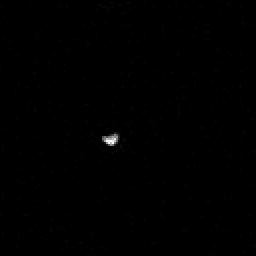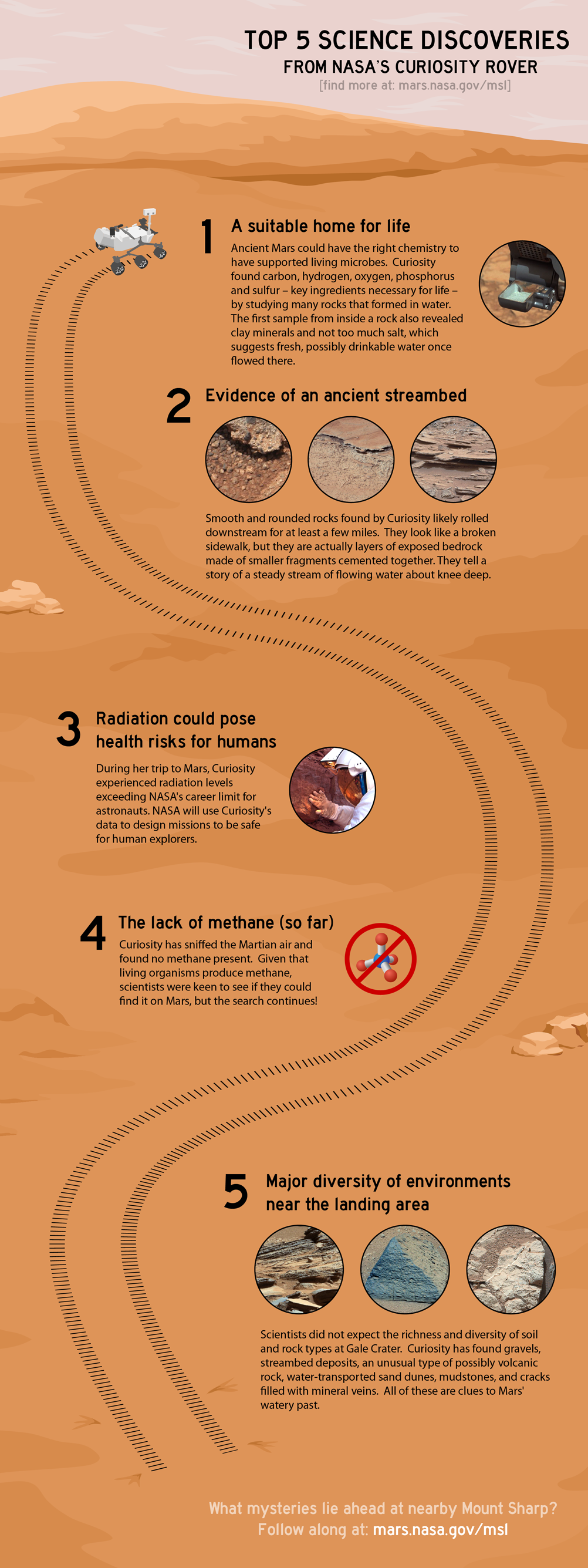I thought of writing only about the moons of Mars today so here goes:
One of the most enchanting things about Mars is its
contradictory mix of alien qualities combined with aspects that make the planet
more earth-like than any other body in the solar system. It has a sky that’s pink
instead of blue, polar caps made of a combination of frozen carbon dioxide and
water rather than just water ice and it has natural satellites, two of them,
called Phobos (meaning ‘fear’ in greek) and Deimos (which means ‘terror’),
appropriate companions for a planet named after the Roman god of war.
Phobos was discovered in 1877 by Asaph Hall, an American astronomy. He also discovered Deimos a few days ago the same year.Phobos is the bigger of the two with dimensions spanning
28 km by 20 km. Deimos measures 16 km by 12 km, almost half of Phobos’ size. From the
surface they appear to move across the Martian night sky in opposite directions;
Phobos rises from the west and sets in the east while Deimos does otherwise. This can be accounted for when one
considers their orbital periods, i.e. the time it takes for a revolving body to
complete a full circle around a point of focus.
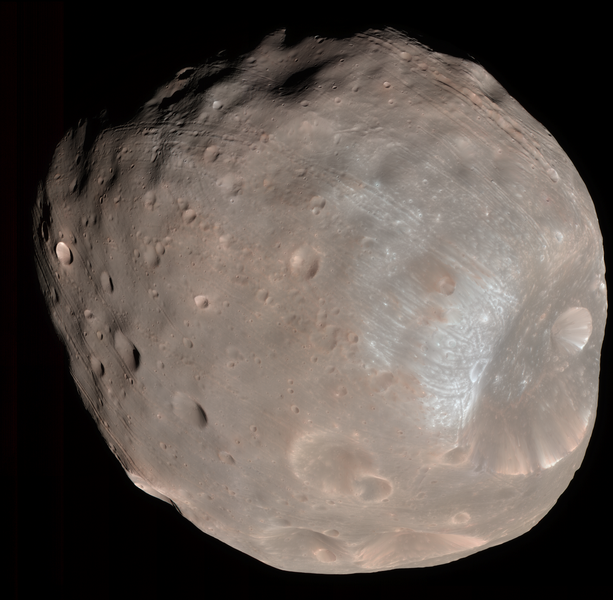 |
Phobos in false colour by Mars Reconnaissance Orbiter
in 2008. Notice the 'big hole' to the right called Stickney and the
the strange grooves leading out of it (NASA/JPL//MSSS/UA) |
By Kepler's third law of planetary motion, we expect the period of orbiting bodies to increase with their distance from the foci. Phobos, orbiting closest to Mars (approx 9300 km), circles Mars once every 7.7 hours. This means that
essentially Mars (which rotates around its axis every 24.6hours) is essentially
playing catch up with its moon. So, instead of the moon appearing to rise and
set from east to west like things here on Earth (which move slower than the
Earth across the sky) it appears to rise from the west and set in the east.
This is similar to what you would see along the highway. When you pass a slower
car at high speed, he appears to be moving backwards. An overtaking Formula One
race car would appear to be moving forwards, leaving you in the dust! It’s all
relative motion. Taking all this we see that an observer on Mars would see
Phobos rise and set every 11 hours roughly. For Deimos (lying almost 23,460km away from Mars) with its orbital period
of 30.3hours, you would see it in the Martain sky every 5.45days roughly.
 |
The 'moon movie' from Curiosity clearly
shows the relative opposing motions
of the two moons. Notice Stickney
crater in the leading edge of Phobos
(NASA/JPL/MSSS) |
Phobos’
surface features are more prominent and diverse in nature than that of Deimos
whose features appear softer. The most prominent feature on Phobos is the massive Stickney
crater (named by the International Astronomical Union after Asaph Hall’s wife),
measuring 9 km in diameter. Strange grooves that resemble a spider’s legs appear
to radiate from the crater. It is still unclear how these lines actually formed
but two schools of thinking suggest that they’re cracks that could have formed
as a result of the impact that formed Stickney in the first place (which being
half the size of Phobos implies a massive event that could have ripped the moon
apart) or they may be a result of the debris that was flung from the impact sit
landing back onto the surface and producing chains of craters that coalesced
into grooves. The interesting thing about these grooves which measure hundreds
of metres across and tens of metres deep is that they don't quite seem to
radiate perfectly from the crater itself and new data from the European orbiter
Mars Express suggest that the impact ‘cracks’ scenario may not be as correct as
first impressions suggested and that the grooves are actually independent of the Stickney crater information. They are indeed are result of falling back of impact debris but not necessarily from the impact that caused Stickney.
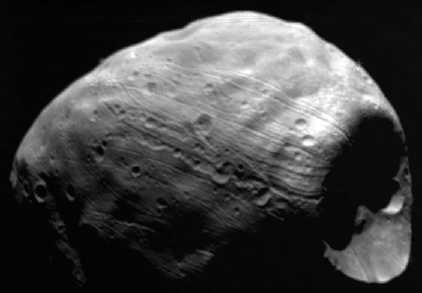 |
| A good relief view of the grooves of Phobos(Commons) |
Deimos is an interesting body in that it doesn’t sport as
much features as its bigger counterpart. In fact it only has 2 officially named
surface features; Swift and Voltaire, Deimos’ two of the moon's larger craters measuring 1km and 1.9km respectively in diameter named after writers who wrote about the moon more than a hundred years before its discovery. The subdued appearance of the surface features suggests a
thick layer of powdered regolith covering most of the surface.
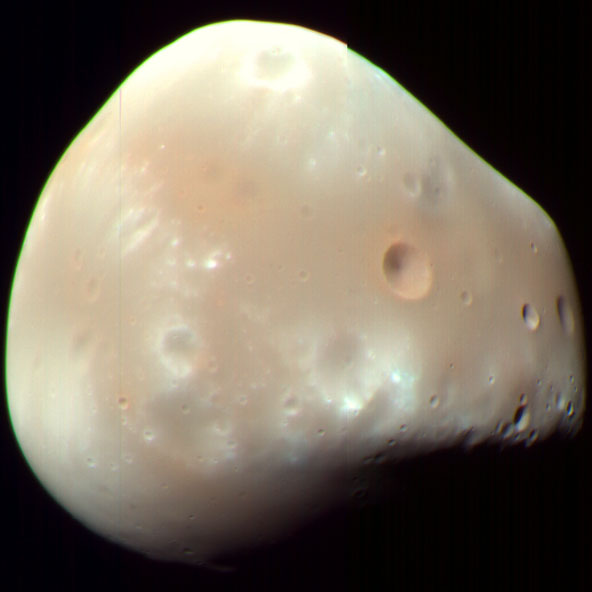 |
Deimos in false colour courtesy of MRO.
The two faint craters that form
an unsymmetrical figure 8
to the lower left are Swift and Voltaire (NASA/JPL/MSSS/UA) |
The composition of the two moons resembles that of some
classes of asteroids, rocks that failed to form planets during the formation of
the solar system 4.6 billion years ago. Phobos and Deimos’ compositions resemble
a class called C-type (classes are determined according to the spectral
signature of the asteroids i.e. the amount of light reflected by these objects
at different wavelengths) the most common of types. These are dark,
carbonaceous bodies with poor reflectance and very little minerals. Some
suggestions indicate a relationship with D-type which features a reddish
colouration and maybe organic compounds and water. Very little hydration has
been detected on surface of these moons but there may be some water ice under
all that layer of regolith. The relatively low densities of the moon (2000 kg/m^3 for Phobos and 1000 kg/m^3 for Deimos) suggest some form of porosity in the bodies, i.e. they're literally space fluff; rocks that have not quite come together to form a thorough solid body.
Their similarities to asteroid classes and their general
appearance suggest that they are indeed captured asteroids that somehow got
trapped in Mars’s gravitational well, perhaps with a little help from an
ancient thicker atmosphere that helped slow these bodies down to their present
orbits. The near circular, near-zero inclinations of the orbits however suggest
the capture theory for the formation of the Martian moons may not be adequately
explanatory. Capture should result in an elliptical orbit, not near perfect
circles. In short, we still have a lot to learn about these two small moons.
So far we have only had flybys of these moons with Mars orbiting
spacecrafts like Mariner 9, the Viking series in the 1970/80s, the Mars Global Surveyor,
Mars Express and the latest Mars Reconnaissance Orbiter. Russia did try to send 3 orbiter and landing mission to Phobos;
Phobos 1 and 2 and the recent Phobos-Grunt in 2011. The first two were launched in the 1980s and
Phobos 1 failed en route,
Phobos 2 got near enough to get pics but also failed and Phobos-Grunt failed to get beyond Earth orbit and burned up during reentry in January 2012.
It would have been wonderful to have a spacecraft studying this moon, both
believed to contain details about the old nebula cloud from which our solar system
emerged. Other missions are on the drawing boards including an American candidate called
Phobos Surveyor.
So the Martian moons continue to beckon us on! Until then, it is up to the current orbiters and rovers to survey these forgotten rocks whenever they have time. The recent observations made by Curiosity will be used to improve our understanding of the orbital mechanics of these moons in order to continue to predict their future movements with great(er) accuracy.







